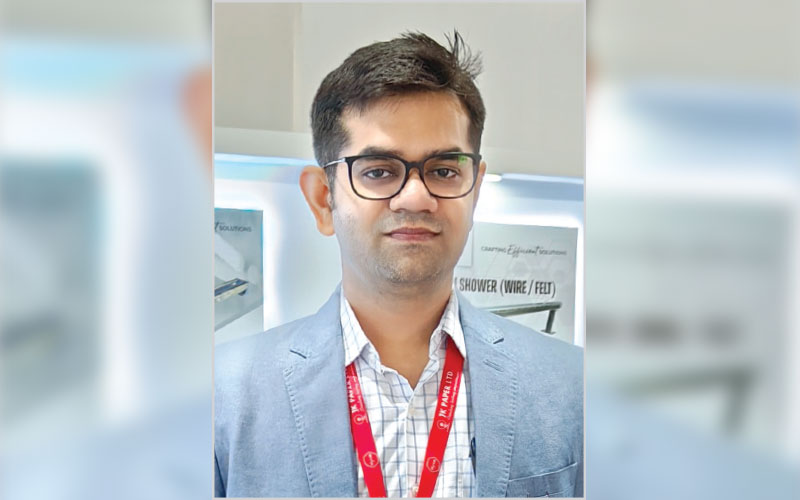Scan Engineering Limited does not view water as a utility, but a vital asset that impacts a paper mills’ sustainability and performance. The company helps mills move closer to achieving water circularity through a range of cleaning systems like turbo clean showers, designed to minimize water usage while maintaining high efficiency and cleanliness on forming fabrics and press sections. Mr. Mihir Mistry, Partner, Scan Engineering, revealed this and much more, during an exclusive interaction with Paper Mart.

Paper Mart: How has your understanding or approach to water circularity evolved over time? How are you helping mills move closer to achieving it?
Mihir Mistry: Over time, our understanding of water circularity has evolved from simply reducing consumption to embracing a more integrated and strategic approach, viewing water as a resource to be continuously recovered, reused, and optimized across mill operations. We’ve come to see water not just as a utility, but as a vital asset that impacts both sustainability and performance.
At Scan Engineering, we help mills move closer to achieving water circularity by introducing technologies that improve internal water reuse and reduce freshwater intake. For example, our range of cleaning systems like turbo clean showers are designed to minimize water usage while maintaining high efficiency and cleanliness on forming fabrics and press sections. By optimizing cleaning processes and reducing contaminants at the source, we help mills lower effluent loads and enhance the quality of recycled water streams, ultimately supporting their circular water goals. We also work closely with mill teams to audit existing water usage patterns and identify practical upgrades that align with circularity targets, all while ensuring cost-effectiveness and minimal disruption to production.
PM: How widely are circular water systems (such as ZLD, membrane filtration, biological treatments, or AI-based monitoring) being adopted in paper mills? What adoption trends are you noticing?
MM: In the Indian paper industry, the adoption of circular water systems like ZLD, membrane filtration and biological treatments is steadily increasing, driven largely by stricter environmental regulations from the pollution control boards and growing awareness around sustainable operations. While full-scale ZLD systems are still limited to larger mills, mainly due to the high capital and operating costs, many mid-sized mills are actively investing in membrane filtration and biological treatment as intermediate steps toward circularity. There’s also a growing interest in AI-based monitoring tools, particularly for tracking water quality and optimizing reuse cycles, although this is still in early stages.
A clear trend we’re noticing is a greater focus on internal water reuse and process water optimization before committing to end-of-pipe solutions. Mills are becoming more proactive in reducing water intake at the source through better cleaning systems and process control, which makes downstream treatment and reuse more feasible. At Scan Engineering, we contribute to this shift by offering equipment like the turbo clean shower, which helps reduce freshwater consumption and lower the load on treatment plants, making it easier for mills to progress toward their circular water goals.
Watch: In Pursuit of Lesser Water Footprint
PM: Based on your experience, which current technologies are having the greatest real-world impact in improving water circularity in paper mills?
MM: In our experience, the technologies delivering the most practical impact on water circularity in Indian paper mills are those that combine efficiency, scalability, and ease of integration into existing operations. Biological treatment systems have become a backbone for many mills, especially when paired with secondary clarification and filtration systems, enabling effective recycling of process water. These systems are now more optimized and reliable than ever, making them a solid choice for mills aiming to reduce freshwater dependency.
On the operational side, high-efficiency cleaning technologies, such as turbo clean showers, are having a significant impact by minimizing water use directly in the machine section. Another impactful area is the increasing use of real-time monitoring and control systems. Though still emerging, they’re enabling smarter water management by identifying leaks, inefficiencies, and opportunities for reuse with greater accuracy. Ultimately, the most effective technologies are those that tackle both source reduction and end-of-pipe treatment, supporting a more circular, cost-effective water strategy for Indian mills.
PM: What are the key challenges your clients face in improving water management or achieving circularity?
MM: Some of the major challenges faced by our clients in achieving circularity include lack of real-time data & monitoring, aging infrastructure, limited capital for upgrades, regulatory complexity, lack of integration between systems, and uncertainty around rate of interest (ROI). Many facilities operate without accurate, real-time information on water usage, losses, and quality, making it difficult to identify inefficiencies or respond proactively. Existing water systems and equipment are often outdated, leading to leaks, inefficiencies, and higher operational costs, especially in older industrial plants.
Budget constraints frequently prevent investment in advanced technologies or system upgrades, even when they promise long-term savings and sustainability. Navigating evolving water use and discharge regulations can be overwhelming, particularly across different regions or countries. Water reuse, recycling, and treatment solutions need to be integrated across processes, but siloed operations or incompatible systems often hinder this. Clients are sometimes hesitant to adopt circular practices due to perceived or unclear return on investment, especially when benefits are long-term or indirect.
PM: How are environmental regulations influencing demand for circular water systems? Are you seeing more compliance-driven innovation?
MM: Environmental regulations are playing a significant role in shaping demand for circular water systems. As requirements around water usage efficiency, discharge limits, and environmental impact reporting become more rigorous, many companies are proactively seeking solutions that support both compliance and sustainability goals.
We are increasingly seeing that compliance is driving innovation. Rather than being seen as an obligation, regulations are prompting industries to adopt smarter, more efficient systems, such as turbo clean systems, which help optimize water usage, reduce contamination, and improve the effectiveness of internal cleaning processes. These systems not only support regulatory compliance but also contribute to long-term water conservation strategies. That said, the pace and scale of adoption can vary depending on industry type, regulatory enforcement, and access to funding or incentives. Overall, regulations are becoming a strong motivator for businesses to shift toward circular water practices and invest in cleaner, more resource-efficient technologies.

We are increasingly seeing that compliance is driving innovation. Rather than being seen as an obligation, regulations are prompting industries to adopt smarter, more efficient systems.
PM: Can you share examples of cost or efficiency gains achieved by mills using your systems for water recycling or Zero Liquid Discharge (ZLD)?
MM: Mills that have implemented our systems, particularly for reducing fresh water consumption & moving towards ZLD, have reported notable gains in both cost efficiency and resource optimization. Our systems, including turbo clean systems, high-efficiency filters, precision-engineered nozzles and low-pressure showers using process water, are designed to optimize internal cleaning, while minimizing freshwater use.
When combined with our water audits services, clients typically see up to 90 percent reduction in freshwater consumption, by enabling more effective reuse of filtered process water; lower energy and chemical usage, as cleaner systems require less frequent shutdowns and use fewer resources for maintenance; reduced effluent loads, contributing directly to easier compliance with ZLD or strict discharge norms; and decreased downtime and maintenance costs, due to improved cleanliness of forming fabrics and other critical components.
While exact figures vary depending on the mill’s setup and goals, most clients have found that the return on investment comes not just from regulatory compliance, but also from tangible savings in operational costs and improved process stability. Our approach focuses not only on equipment supply but also on process assessment and ongoing support, helping mills implement practical and cost-effective steps towards more circular water management.
PM: How do you co-create solutions with mills? Are there examples of partnerships that led to better water management outcomes?
MM: We believe in a collaborative, solution-oriented approach when working with mills to improve water management. Rather than offering one-size-fits-all products, we focus on co-creating customized solutions by closely engaging with mill teams to understand their specific processes, challenges, and sustainability goals. Our co-creation process typically involves on-site audits and system assessments to identify inefficiencies in water usage, cleaning, and discharge; jointly developing tailored configurations of our equipment, such as turbo clean systems, low-pressure showers, filters, and nozzles, to match the mill’s operating conditions; and implementing water minimizing strategies, supported by our technical team, to ensure optimal performance and ongoing improvements.
One example of this collaborative approach was when a paper mill was facing high water consumption and fabric clogging issues. Working together, we re-engineered their cleaning system using our turbo clean setup and low-pressure shower technology. The result was an 85 percent reduction in freshwater usage, improved machine cleanliness, and significantly lower downtime for maintenance. These outcomes become possible because we treat each engagement as a partnership, not just a supply contract, focused on shared performance goals and long-term benefits.
Also Read: Paques India: Closing The Loop on Water Use in Pulp and Paper Industry
PM: Looking ahead, which emerging technologies or innovation models (such as digital twins, decentralized systems, or AI/IoT platforms) could radically improve water circularity in the next 5–10 years?
MM: Looking ahead, several emerging technologies and innovation models have strong potential to significantly advance water circularity in the next 5-10 years. Among them, a few stand out, such as AI-driven monitoring and control systems, decentralized water treatment systems, smart shower and cleaning technologies, and cloud-based water management platforms. Artificial Intelligence, when combined with IoT sensors, can enable real-time water quality and flow monitoring, predictive maintenance and smart control of cleaning systems. This allows mills to optimize water use, reduce waste and respond quickly to inefficiencies.
Modular, decentralized treatment units are becoming more viable, especially for mills in regions with water scarcity or strict discharge limits. These systems allow for targeted treatment and reuse within specific parts of the process, increasing flexibility and efficiency. Innovations in low-pressure shower systems, intelligent nozzles, and automated fabric cleaning, like those integrated in our turbo clean systems, can be enhanced further with sensor feedback and adaptive controls for even better water conservation. Centralized dashboards aggregating water use data across multiple facilities can help companies track, compare and optimize their circular water goals more effectively.
In the coming years, we see a shift toward fully integrated systems, where equipment, data and decision-making tools are connected in real time to drive both sustainability and performance.



